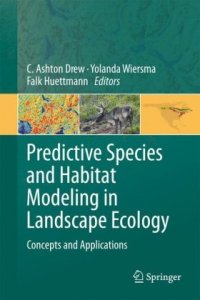
Ebook: Predictive Species and Habitat Modeling in Landscape Ecology: Concepts and Applications
Author: Yolanda F. Wiersma Falk Huettmann (auth.) C. Ashton Drew Yolanda F. Wiersma Falk Huettmann (eds.)
- Genre: Biology // Ecology
- Tags: Landscape Ecology, Theoretical Ecology/Statistics, Fish & Wildlife Biology & Management, Conservation Biology/Ecology, Nature Conservation, Community & Population Ecology
- Year: 2011
- Publisher: Springer-Verlag New York
- Edition: 1
- Language: English
- pdf
Much research in landscape ecology makes use of spatial models to define species-habitat associations. The early years of landscape ecology necessarily focused on the evolution of effective data sources, metrics, and statistical approaches that could truly capture the spatial and temporal patterns and processes of interest. Now that these tools are well established, we reflect in this volume on the ecological theories that underpin the assumptions commonly made during species distribution modeling and mapping. This is crucial for applying models to questions of global sustainability. This book will offer a unique perspective on modeling within the discipline of landscape ecology, which complements that of other recent publications. Through chapters that focus on particular aspects of modeling, illustrative case studies, and surveys of the field of modeling, this book illustrates that we can (and need to) pay attention to the foundational ecological theories and assumptions which support model development. We show how this can be done in modeling through theory, traditional inference, and predictions. Chapter authors have attempted to critically identify, evaluate, and even formally test these ecological theories and have also written thoughtful reflections on the state of landscape-scale species/habitat modeling. Predictive Species and Habitat Modeling in Landscape Ecology: Concepts and Applications is intended to be useful to researchers in landscape ecology, as well as those in conservation biology, wildlife management, population and community ecology, and general ecology. The book will be a valuable resource for graduate students incorporating landscape ecology and/or species modeling in their degree programs. About the Editors C. Ashton Drew is a postdoctoral researcher in the USGS North Carolina Cooperative Fish and Wildlife Research Unit, North Carolina State University. Her research interests focus on how models can support adaptive monitoring and management. Yolanda F. Wiersma is Assistant Professor in Biology at Memorial University (Canada). She conducts research in Boreal Landscape Ecology, with a focus on models of wildlife-habitat interactions, forestry and protected areas. Falk Huettmann is Associate Professor in the Biology and Wildlife Department, Institute of Arctic Biology, University of Alaska-Fairbanks. His research interests are in wildlife/habitat modeling, GIS and remote sensing, and data management worldwide.
Most projects in Landscape Ecology, at some point, define a species-habitat association. These models are inherently spatial, dealing with landscapes and their configurations. Whether coding behavioral rules for dispersal of simulated organisms through simulated landscapes, or designing the sampling extent of field surveys and experiments in real landscapes, landscape ecologists must make assumptions about how organisms experience and utilize the landscape. These convenient working postulates allow modelers to project the model in time and space, yet rarely are they explicitly considered. The early years of landscape ecology necessarily focused on the evolution of effective data sources, metrics, and statistical approaches that could truly capture the spatial and temporal patterns and processes of interest. Now that these tools are well established, we reflect on the ecological theories that underpin the assumptions commonly made during species distribution modeling and mapping. This is crucial for applying models to questions of global sustainability.
Due to the inherent use of GIS for much of this kind of research, and as several authors’ research involves the production of multicolored map figures, there would be an 8-page color insert. Additional color figures could be made available through a digital archive, or by cost contributions of the chapter authors. Where applicable, would be relevant chapters’ GIS data and model code available through a digital archive. The practice of data and code sharing is becoming standard in GIS studies, is an inherent method of this book, and will serve to add additional research value to the book for both academic and practitioner audiences.